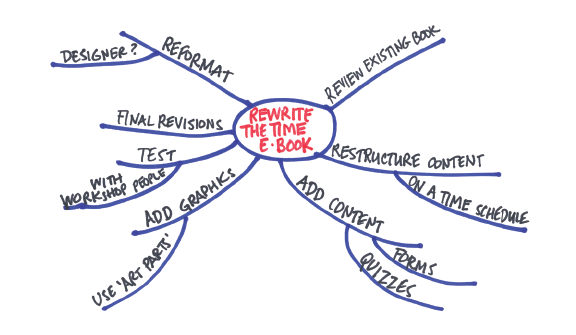THE PRINCIPLE
Creating a diagram of what you need to do focuses your activity
In the previous part, I suggested using a mind map to bring out all your thoughts about an idea you want to develop. At that point, having ideas all over the place is fine, it’s a part of expanding your thinking. However, now that you are taking action, what you need is an action map.
An action map uses the same basic structure as a mind map but instead of ideas you are mapping tasks, and instead of a random order you are using a chronological order.
The sample action map below illustrates the process. The project name is in the oval in the centre. In this case, the project is to rewrite my ebook on Time Management. I’ve gone through the stage of brainstorming how to make it even more useful, and now it’s time to implement those ideas.

Again, we start at the one o’clock position. The first task is to review the existing book again to get my mind focused on the topic. Then we move clockwise to the next task, which is restructuring the content. Coming off that branch is the sub-branch that says ‘on a time schedule’. What I mean by this is that I plan to put the content into a structure that readers can use step by step, week by week, to reclaim their time.
The next branch is ‘add content’ and the sub-branches indicate that two types of new content are: (i) forms readers can fill out to help them apply the principles to their own life; and (ii) quizzes that help them figure out what they need to do.
The next branch is ‘add graphics’ because I plan to add more visuals. The sub-branch, ‘use Art Parts’, relates to the name of a set of graphics that I own.
Next is ‘test’, because I always like to make sure that everything that I offer has actually worked not only for me but also for others. I have a workshop coming up and will offer test versions of the new materials to the participants.
Next is ‘final revisions’, which will incorporate any feedback from my test group, and the last step is to ‘reformat’ the ebook. I’ve indicated that I’m not sure yet whether I will do this myself or get a graphic designer to do it.
One of the key benefits of using an action map is that it forces you to think through the entire process. If some steps are not clear yet, jot down what you think they will be, but add a question mark. You can always quickly add to or redraw the action map as new information comes up. Typically, I will redraw my action map at least three times over the course of a project.
Having thought the process through, you end up with a concise, easy-to-read plan for achieving it. You can use a highlighter pen to cross off each step as you finish it.
When you have finished the project, keep the action map because it may come in handy if you want to do a similar project in the future. Instead of reinventing the wheel, you will start with an approach that has already shown itself to be successful.
